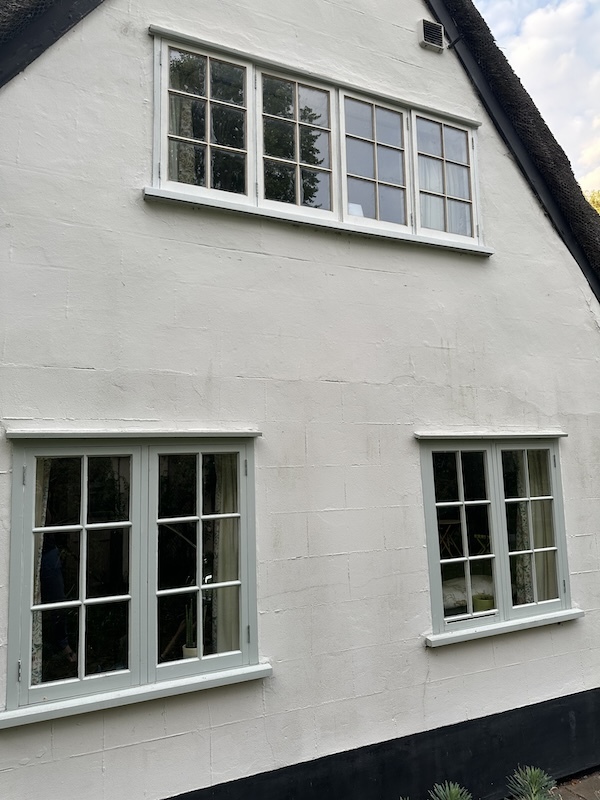This month we talked to Ben and Richard about how they have improved their listed cottage after experiencing a very cold house during their first winter there.
Ben and Richard live in Mill Cottage in Littlebury, a cottage formed from two original 18th Century dwellings with a 20thCentury kitchen extension and a 21st Century second extension. The cottage is a Listed Building and is in the Littlebury Conservation Area.
In December 2021 when they moved in, the heating was a multi-fuel stove with a back burner, electric underfloor heating downstairs and electric heaters upstairs. Windows were single glazed apart from a few in the new extension. The surveyor described the roof insulation as not to modern standards, which meant there were two joist gaps with 10 cm of insulation and the rest were without insulation.
What motivated you to improve the cottage?
Ben and Richard said “On the first day, we turned the thermostat to 18°C and found that we were using electricity at £25 per day. This wasn’t sustainable so we stopped heating the whole house to more than a frost protection level and lived mostly in a modern annex office and the living room which we heated. Even then it was hard to get the living room to a comfortable level. This really motivated us to look at what we could do to retain heat and use more efficient heating”
What steps did you take?
“The first thing we did was to invest in a thermal camera to see where we were losing heat. This showed that heat was leaking out of the single glazed windows, and several places where there were draughts coming directly into the living area, like the letter box and key holes. The loft hatch was also completely uninsulated, and we could see that it was cold with the camera.”




“So we decided that phase one would be to tackle the obvious quick and easy wins, like fitting draught excluders to the letterbox and keyholes. We also fitted thermal lined curtains floor to ceiling to replace the previous blinds, using French curtain poles to enclose the windows and a rising door curtain pole for the front door. We added thermal foil insulation to the loft hatch.”
“We also removed the old fibreglass insulation from the roof and added 30 cm of combination sheep’s wool and recycled plastic insulation (Thermafleece CosyWool) roll. You can fit this material yourself with less risk than fibreglass insulation, and the product allows the house to “breathe” naturally.”

What about the windows?
“We started on this at the same time, but the administration to get Listed Building Consent was very long winded. Eventually we got consent to add internal aluminium secondary glazing to the front of the house, which had a mix of original and 20 year-old windows.”
“We then wanted to add double-glazing to the side and rear aspect windows. It took another 12 months for the Listed Building consent, including a site visit. We kept the window frames and added slimline wooden units into these.”


What did you do about the heating?

“We replaced the original 5kW back burner with a modern wood-only burner/boiler which can provide 10 kW. It burns logs but because it is specified as wood-only rather than multifuel it qualifies as a biomass boiler and was VAT exempt. We spent £800 on wood last winter which we buy from various local sources. This provides hot water including showers and high surface area radiators which we added to replace the electric heating. After changing the boiler, we were able to heat the house to a more liveable temperature.”
“We also decided to install a thermal store. This is basically a large hot water tank which is heated by external sources, in our case from the wood burner initially. This now supplies the hot water using a coil and radiators directly from the tank with better pressure than the original gravity fed tank. There is a backup immersion heater which we use in the summer. It was important to install the boiler to be compatible with an Air Source Heat Pump (ASHP), for us to consider more modern heating sources in the future.”
What’s next?
“After all this we have a better insulated house and can support a sustainable heating solution. In the next month or so we will be installing a 12 kW Samsung ASHP which will also heat the thermal store and take over 100% of the heating, helped by the new boiler stove in the coldest days of winter. It will be installed by Infinite Heating and Energy of Cambourne. We are now also looking at solar panels for the roofs that are not directly facing onto the street. Watch this space!”
Any other tips?
“One thing we made sure of was to do our research beforehand because of the complexity of an old house, and because we wanted a Smart Home with compatible technology without being tied to single brands. In the end we have been able to create a unified system that we can control with Open Source software (Home Assistant) and use a flexible electricity tariff such as Agile Octopus”.
“One other thing to note is that the software that the suppliers use to estimate heat loss, for instance when specifying an ASHP, is not really designed for old houses which adds an extra complication, so it’s advisable to choose a company that specialises in Listed Buildings.”
